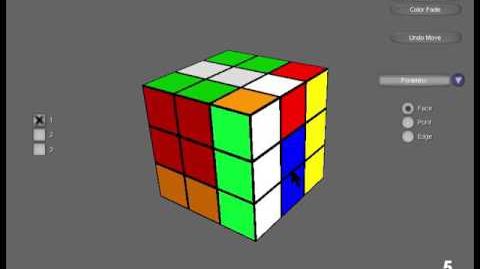Most 3×3×3 Rubik's Cube solution guides use the same notation, originated by David Singmaster, to communicate sequences of moves. This is generally referred to as "Cube notation" or in some literature "Singmaster notation" (or variations thereof). Its relative nature allows algorithms to be written in such a way that they can be applied regardless of which side is designated the top or how the colours are organized on a particular Cube.
- F (Front): the side currently facing you
- B (Back): the side opposite the front
- U (Up): the side above or on top of the front side
- D (Down): the side opposite Up or on bottom
- L (Left): the side directly to the left of the front
- R (Right): the side directly to the right of the front
When a prime symbol ['] follows a letter, it means to turn the face counter-clockwise a quarter-turn, while a letter without a prime symbol means to turn it a quarter-turn clockwise. Such a symbol is pronounced prime. A letter followed by a 2 (occasionally superscript) means to turn the face a half-turn (the direction does not matter). Likewise, a number following a bracketed sequence means to do that sequence that number of times: for example, (F2 R2)3 = F2 R2 F2 R2 F2 R2, which does the two swaps UF-DF and UR-DR.
This notation can also be used on the Pocket Cube, the Revenge, and the Professor, with additional notation. They not only have the F, B, L, R, U, D notation but also f, b, l, r, u, d. For example: (Rr)' l2 f'. They also work for V-Cubes 6&7.
(Some solution guides, including Ideal's official publication, The Ideal Solution, use slightly different conventions. Top and Bottom are used rather than Up and Down for the top and bottom faces, with Back being replaced by Posterior. + indicates clockwise rotation and - counterclockwise, with ++ representing a half-turn. However, alternative notations failed to catch on, and today the Singmaster scheme is used universally by those interested in the puzzle.)
Less often used moves include rotating the entire Cube or two-thirds of it. The letters x, y, and z are used to indicate that the entire Cube should be turned about one of its axes. The X-axis is the line that passes through the left and right faces, the Y-axis is the line that passes through the up and down faces, and the Z-axis is the line that passes through the front and back faces. (This type of move is used infrequently in most solutions, to the extent that some solutions simply say "stop and turn the whole Cube upside-down" or something similar at the appropriate point.)
Lowercase letters f, b, u, d, l, and r signify to move the first two layers of that face while keeping the remaining layer in place. This is of course equivalent to rotating the whole Cube in that direction, then rotating the opposite face back the same amount in the opposite direction, but is useful notation to describe certain triggers for speedcubing. Furthermore, M, E, and S [middle, equatorial, and side] (and respectively their lowercase for larger sized cubes), are used for inner-slice movements. M signifies turning the layer that is between L and R downward (clockwise if looking from the left side). E signifies turning the layer between U and D towards the right (counter-clockwise if looking from the top). S signifies turning the layer between F and B clockwise.
For example, the algorithm (or operator, or sequence) F2 U' R' L F2 R L' U' F2, which cycles three edge cubes in the top layer without affecting any other part of the Cube, means:
- Turn the Front face 180 degrees
- Turn the Up face 90 degrees counterclockwise
- Turn the Right face 90 degrees counterclockwise
- Turn the Left face 90 degrees clockwise
- Turn the Front face 180 degrees
- Turn the Right face 90 degrees clockwise
- Turn the Left face 90 degrees counterclockwise
- Turn the Up face 90 degrees counterclockwise
- Finally, turn the front face 180 degrees.

Edge three-cycle demo using Ultimate Magic Cube
Animated version of the above sequence
For beginning students of the Cube, this notation can be daunting, and many solutions available online therefore incorporate animations that demonstrate the algorithms presented. For an example, see the video to the right, and this list of notations with pictures.
4×4×4 and larger Cubes use slightly different notation to incorporate the middle layers. Generally speaking, upper case letters (FBUDLR) refer to the outermost portions of the cube (called faces). Lower case letters (fbudlr) refer to the inner portions of the cube (called slices). Again Ideal breaks rank by describing their 4×4×4 solution in terms of layers (vertical slices that rotate about the Z-axis), tables (horizontal slices), and books (vertical slices that rotate about the X-axis).